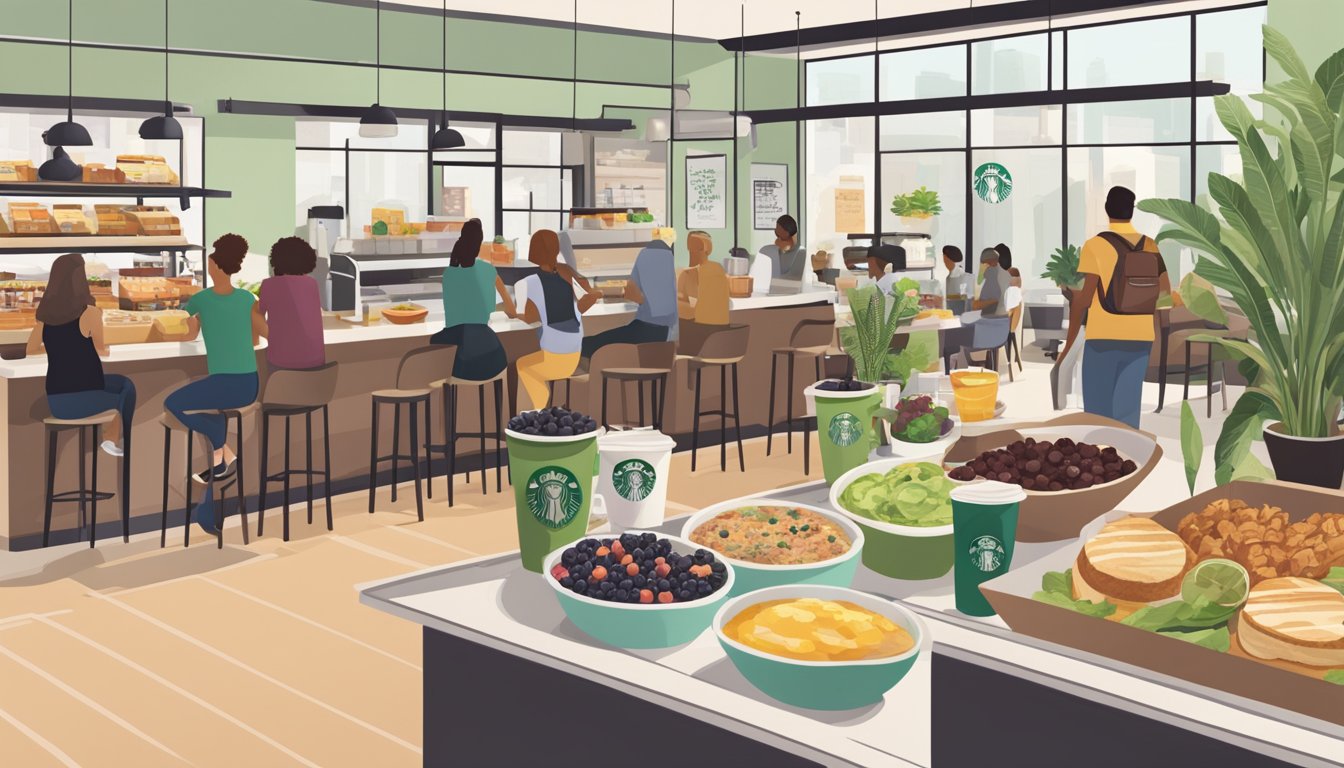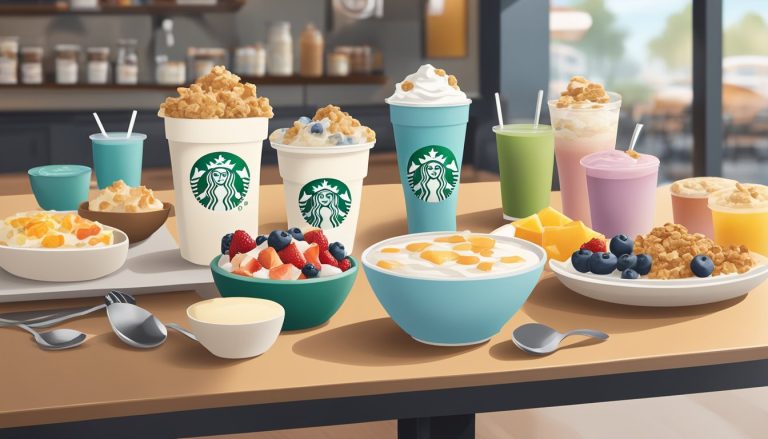Starbucks has long been a trendsetter in the coffee industry, but its breakfast offerings have become increasingly important to its business strategy. The company’s food sales now account for nearly $6 billion annually in North America, with about half of that coming from all-day breakfast items. This shift reflects Starbucks’ responsiveness to changing consumer preferences and lifestyle trends, particularly the growing demand for healthier and more convenient food options.
As health-conscious consumers seek nutritious on-the-go meals, Starbucks has expanded its menu to include items like sous vide egg bites and a variety of breakfast sandwiches. These offerings cater to customers looking for protein-rich, portable breakfast options that complement their morning coffee routine. The success of these items is evident in the 19% year-over-year increase in breakfast sandwich sales.
The company’s focus on food trends extends beyond just health considerations. Starbucks has also recognized the importance of sustainability and ethical sourcing in its product development. By aligning its offerings with these values, Starbucks aims to appeal to environmentally conscious consumers who are increasingly making purchasing decisions based on a brand’s social responsibility efforts.
The Evolution of Starbucks’ Breakfast

Starbucks has transformed its breakfast offerings over the years, adapting to changing consumer preferences and food trends. The coffee giant’s morning menu has expanded from simple pastries to a diverse array of options catering to health-conscious millennials and Gen Z customers.
Historical Context: Breakfast at Starbucks
In its early days, Starbucks focused primarily on coffee and basic pastries. The company’s breakfast menu was limited to muffins, scones, and croissants. As customer demand grew, Starbucks introduced more substantial options.
In the late 1990s, breakfast sandwiches made their debut. These warm, portable meals quickly gained popularity among busy commuters. The introduction of oatmeal in 2008 marked Starbucks’ entry into healthier breakfast territory.
By 2010, Starbucks had established itself as a serious contender in the breakfast market. The company expanded its offerings to include protein boxes, yogurt parfaits, and smoothies.
Influence of Millennials and Gen Z on Menu Changes
Millennials and Gen Z have significantly impacted Starbucks’ breakfast evolution. These demographics prioritize health, sustainability, and unique flavors. In response, Starbucks has introduced plant-based options and locally-sourced ingredients.
Avocado toast, a millennial favorite, joined the menu in select locations. Protein-packed egg bites became a hit among fitness-conscious customers. Starbucks also embraced the smoothie bowl trend, offering fruit and granola-topped creations.
The company has increased its focus on customization, allowing customers to modify their breakfast orders. This flexibility appeals to younger generations who value personalized experiences.
To meet the demand for convenient, on-the-go options, Starbucks expanded its grab-and-go selections. These include pre-packaged sandwiches, wraps, and fruit cups designed for busy lifestyles.
Consumer Trends Shaping Breakfast Offerings
Breakfast offerings at Starbucks are evolving to meet changing consumer preferences. Health-conscious choices, flexible eating times, and personalized experiences are driving menu innovations.
Health and Wellness Focus
Starbucks is adapting its breakfast menu to cater to health-conscious consumers. The company has introduced more nutrient-dense options, incorporating whole grains, superfoods, and plant-based alternatives. Protein-packed items like egg white wraps and oatmeal with added nuts and seeds have gained popularity.
Low-calorie and gluten-free choices are now prominent on the menu. Smoothie bowls featuring acai and other antioxidant-rich fruits have been introduced to appeal to the wellness-focused crowd.
Starbucks has also expanded its selection of organic and non-GMO ingredients, responding to growing consumer demand for cleaner labels and transparency in food sourcing.
All-Day Breakfast and Snacking
The lines between traditional meal times are blurring, prompting Starbucks to offer breakfast items throughout the day. This shift caters to diverse schedules and the rising trend of snackification.
Portable options like breakfast sandwiches and protein boxes have seen increased demand, appealing to on-the-go consumers seeking quick, satisfying meals. These items serve dual purposes as both breakfast and snack options.
Starbucks has also introduced smaller portion sizes and snack-sized versions of popular breakfast items. This strategy allows customers to enjoy breakfast flavors at any time without committing to a full meal.
Personalization and Consumer Engagement
Starbucks is leveraging technology to enhance personalization in its breakfast offerings. The company’s mobile app allows customers to customize their orders, saving preferences for future visits.
Seasonal and limited-time breakfast items create excitement and encourage repeat visits. These offerings often reflect current food trends and local tastes, keeping the menu fresh and engaging.
Starbucks has implemented a rewards program that offers personalized promotions on breakfast items based on customer purchase history. This data-driven approach helps tailor offerings to individual preferences.
The company also actively seeks customer feedback through surveys and social media, using this input to refine and develop new breakfast options.
Breakfast Menu Innovations

Starbucks has transformed its breakfast offerings through strategic menu additions and innovative creations. The coffee giant has focused on expanding its food options while maintaining its signature beverage quality.
Expansion of Breakfast Sandwiches
Starbucks has significantly expanded its breakfast sandwich lineup to cater to diverse tastes and dietary preferences. The introduction of the Impossible Breakfast Sandwich in June marked a major step towards plant-based options. This sandwich features a plant-based sausage patty, appealing to vegetarian and flexitarian customers.
Traditional breakfast sandwiches have also seen upgrades. Starbucks now offers a variety of protein options, including turkey bacon and cage-free eggs. These choices reflect consumer demand for healthier, high-quality ingredients.
To enhance convenience, Starbucks has introduced portable breakfast items like French toast sticks. These easy-to-eat options cater to on-the-go customers seeking quick, satisfying morning meals.
Introduction of Sous Vide Egg Bites
Starbucks revolutionized its breakfast menu with the launch of Sous Vide Egg Bites. These protein-rich, low-carb options quickly gained popularity among health-conscious customers and those following specific diets.
The egg bites are prepared using the sous vide cooking method, resulting in a velvety texture and consistent flavor. Starbucks offers various flavors, including bacon and gruyere, egg white and roasted red pepper, and kale and mushroom.
This innovative product addresses the growing demand for high-protein breakfast options that are both convenient and satisfying. The egg bites have become a staple for customers seeking a quick, nutritious breakfast or snack.
Specialty Coffee Pairings
Starbucks has expertly crafted breakfast pairings that complement its renowned coffee offerings. The company has introduced specialty beverages designed to enhance the breakfast experience.
Cold Brew with Cinnamon Almondmilk Foam and Cold Brew with Dark Cocoa Almondmilk Foam are examples of plant-based beverage innovations. These drinks pair well with both savory and sweet breakfast items, offering a complete morning package.
Starbucks has also focused on seasonal flavors, introducing limited-time offerings that align with holidays and changing consumer preferences. These specialty drinks, combined with carefully curated food items, create a cohesive breakfast menu that appeals to a wide range of customers.
Impact of Competitive Landscape
Starbucks faces intense competition in the breakfast and coffee market. The company has adapted its strategies to maintain its market position and drive food sales growth.
Response to McDonald’s All-Day Breakfast
Starbucks adjusted its breakfast offerings in response to McDonald’s all-day breakfast launch. The coffee giant expanded its food menu, introducing more substantial breakfast items like protein boxes and hot sandwiches. This move aimed to retain customers who might be tempted by McDonald’s expanded breakfast hours.
Starbucks also focused on improving its food quality and variety. The company introduced healthier options and premium ingredients to differentiate itself from fast-food competitors. These changes helped Starbucks maintain its appeal to health-conscious consumers.
To combat McDonald’s convenience factor, Starbucks enhanced its mobile ordering and drive-thru services. This allowed customers to quickly grab breakfast items on-the-go, matching the speed of fast-food rivals.
Starbucks’ Approach to Food Sales Growth
Starbucks implemented several strategies to boost food sales and increase store traffic. The company revamped its bakery offerings, partnering with local bakeries to provide fresh, artisanal items. This move aimed to create a more upscale dining experience compared to fast-food competitors.
The coffee chain also introduced limited-time seasonal food items to generate buzz and drive repeat visits. These special offerings complemented Starbucks’ popular seasonal beverages, creating attractive food and drink pairings.
Starbucks leveraged its loyalty program to promote food sales. The company offered bonus points for food purchases, encouraging customers to add food items to their drink orders. This strategy helped increase the average transaction value and food attachment rate.
To address changing consumer preferences, Starbucks expanded its plant-based and gluten-free options. This move catered to dietary trends and attracted health-conscious customers seeking alternatives to traditional fast-food breakfast items.
Sustainability and Ethical Sourcing
Starbucks has integrated sustainability and ethical sourcing into its core business practices. These initiatives focus on responsible coffee production and supporting farming communities worldwide.
Corporate Commitments to Sustainability
Starbucks has set ambitious goals to reduce its environmental impact. The company aims to cut carbon emissions, water usage, and waste by 50% by 2030. They’ve introduced recyclable and compostable packaging in many locations. Starbucks also invests in renewable energy, with over 1,600 stores powered by wind and solar energy.
In 2020, Starbucks launched a $10 million Global Farmer Fund to support coffee farmers in implementing sustainable practices. This fund provides low-interest loans to farmers for equipment upgrades and crop diversification.
Ethical Sourcing and Specialty Coffee
Starbucks’ C.A.F.E. (Coffee and Farmer Equity) Practices program is central to its ethical sourcing efforts. This program, developed with Conservation International, verifies farms against economic, social, and environmental criteria.
C.A.F.E. Practices promotes transparent and sustainable coffee growing while protecting farmer welfare. Starbucks has committed to sourcing 100% of its coffee through this program.
The company also works directly with farmers to improve coffee quality and yield. These partnerships help secure a stable supply of high-quality, ethically sourced coffee for Starbucks’ specialty offerings.
Customer Loyalty and Engagement

Starbucks has mastered the art of fostering customer loyalty through innovative programs and enhanced experiences. The company’s approach combines digital solutions with personalized service to keep customers coming back.
Role of Loyalty Programs
Starbucks Rewards stands out as a cornerstone of the company’s customer retention strategy. With millions of active members globally, this tiered program incentivizes frequent visits and higher spending. Members earn “stars” for purchases, which can be redeemed for free food and drinks.
The program’s success lies in its simplicity and the tangible benefits it offers. Mobile ordering, a key feature, allows customers to skip lines and customize their orders easily. This convenience factor has significantly boosted engagement and sales.
Starbucks also uses the loyalty program to gather valuable data on customer preferences. This information helps tailor marketing efforts and inform product development, including breakfast offerings.
Innovations in Customer Experience
Starbucks continually evolves its customer experience to stay ahead of food trends and maintain engagement. The company’s mobile app serves as a hub for ordering, payments, and rewards management, streamlining the customer journey.
In-store experiences focus on creating a welcoming atmosphere. Baristas are trained to provide personalized service, often remembering regular customers’ names and orders. This human touch reinforces the brand’s community-oriented image.
Starbucks also leverages social media to connect with customers. User-generated content and responsive customer service on these platforms enhance brand loyalty and create a sense of community among patrons.
The company’s commitment to sustainability and ethical sourcing resonates with many customers, further strengthening their emotional connection to the brand.
Future Directions for Starbucks’ Breakfast

Starbucks is poised to evolve its breakfast offerings in response to shifting consumer preferences and emerging food trends. The company aims to expand its menu while adapting to changing tastes and lifestyles.
Potential Areas for Menu Development
Starbucks plans to diversify its breakfast options with innovative products. The company is exploring sous vide egg bites and additional breakfast sandwich varieties to cater to protein-focused consumers. Plant-based alternatives are likely to feature prominently, addressing the growing demand for vegetarian and vegan choices.
Starbucks may introduce more grab-and-go items suitable for customers with busy schedules. These could include portable breakfast bowls or convenient wrap formats. The company is also considering expanding its selection of healthier options, such as whole grain pastries and fruit-based offerings.
To complement its coffee selection, Starbucks might develop new breakfast-oriented beverage options. This could include specialty teas, smoothies, or even breakfast-inspired coffee drinks.
Adapting to Changing Consumer Tastes
Starbucks recognizes the shift in consumer behavior, with more people working from home and visiting coffee shops later in the day. In response, the company is likely to extend its breakfast menu availability throughout the day, catering to customers seeking morning fare at non-traditional times.
The company may focus on enhancing its loyalty program to incentivize breakfast purchases. This could involve exclusive breakfast deals or personalized recommendations based on customer preferences.
Starbucks is expected to emphasize sustainability in its breakfast offerings. This may include sourcing more locally produced ingredients and introducing eco-friendly packaging for takeaway breakfast items.
To stay competitive, Starbucks will likely continue to monitor food trends and adjust its breakfast menu accordingly. This could involve incorporating global flavors or experimenting with unique ingredient combinations to appeal to adventurous palates.




